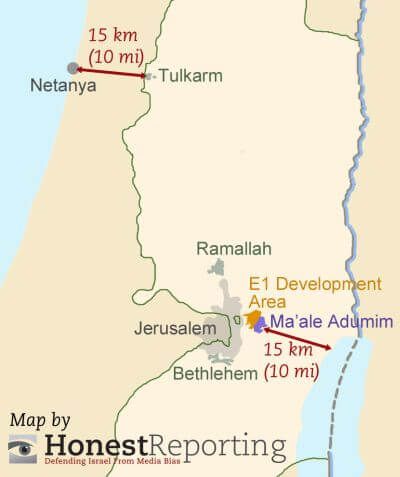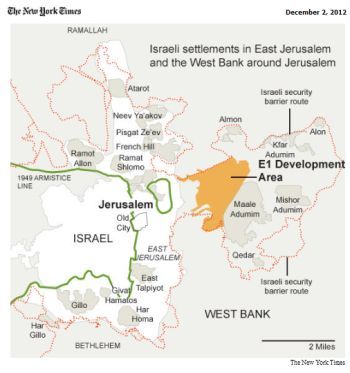The patch of land the world’s fixated on today is roughly 4.5 square miles adjacent to Jerusalem and Maale Adumim. There’s no fancy name to the place. It’s simply known by the bureaucratic moniker, E1.
After the UN General Assembly unilaterally boosted the Palestinians to non-member observer state and a Mahmoud Abbas speech that piqued Israeli officials, Jerusalem responded by dusting off old plans to develop E1. We’re talking about 3,000 housing units.
Settlement activity’s a divisive issue, even among Israelis. But let’s get one thing clear.
Developing E1 doesn’t divide the West Bank in two. It doesn’t wreck the contiguity of a future Palestinian state. Even if Israel does move forward with these plans (and this isn’t the first time over the years that E1 bureaucracy made news and was then put on hold), the remaining land available to the Palestinians will still leave them with territorial contiguity.
The Palestinian waistline — between Maale Adumim and the Dead Sea, is roughly 15 km wide. That’s a corridor no different than the Israeli waistline. Indeed, that has never caused a problem of Israeli territorial contiguity.

And yet today’s papers repeat and reinforce the same Palestinian hype. Among the culprits:
• Los Angeles Times correspondent Ed Sanders:
The hillside development, known as E-1, would connect the West Bank settlement of Maale Adumim with East Jerusalem, cutting off access between the Palestinian cities of Ramallah and Bethlehem.
• AFP:
Palestinians bitterly oppose the E1 project, as it effectively cuts the occupied West Bank in two, north to south, and makes the creation of a viable Palestinian state highly problematic.
(To its credit, AFP produced a decent map, though I wonder how many people saw it).
• BBC (which included a vague map):
Plans to build settlements in the area, known as E1, are strongly opposed by Palestinians, who say the development will cut the West Bank in two, preventing the creation of a contiguous Palestinian state.
• New York Times bureau chief Jodi Rudoren writes:
Construction in E1, in West Bank territory that Israel captured in the 1967 war, would connect the large Jewish settlement of Maale Adumim to Jerusalem, dividing the West Bank in two.
I have an extra bone to pick with the NYT. Their headline played up the inaccurate division, then produced a map that didn’t show E1 in the context of the West Bank. An accurate map would’ve contradicted the sexy headline and allowed readers to judge for themselves:
![]()

• Daily Telegraph reporter Robert Tait:
Reports said some of the new homes would be built in a disputed area known as E1, between the Maale Adumim settlement and east Jerusalem, dividing the northern and southern part of the West Bank.
• Washington Post correspondent Joel Greenberg:
Critics said planned building near Jerusalem would cut links between the northern and southern West Bank, seriously damaging prospects for a viable Palestinian state.
What a load of hooey.
Public debate about settlement activity is heated enough. Big Media hyperbole doesn’t benefit anyone.

